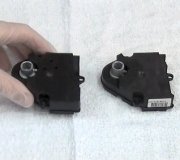Almost all intermittent failures on Ford generators are due to worn brushes. The engineers came up with a design in the '90s that is almost as easy to diagnose as all Chrysler alternators. They couldn't have that so they covered up the key test point starting with 2001 models. You should still be able to test your generator right on the engine. If you look on the back of it, you'll see the voltage regulator bolted on with four screws in a square pattern. It will be gray or black plastic. Nearer the center bearing will be two more screws. One will have a plastic cap over it if it hasn't fallen off yet. If you look closely at the other one, you'll see molded in the plastic, "Ground here to test". Clip a jumper wire to the case or engine block, then touch the other end to that terminal while the engine is running and the problem is occurring. Do that just long enough to see the results, and do not increase engine speed during that test.
If you turn on the head lights, you can use them as an indicator, otherwise you'll need to connect a voltmeter across the battery terminals. In the rare event the voltage goes up and the head lights get brighter when you attach the jumper wire, the voltage regulator is defective. You just bypassed it to allow the rest of the system to work.
If there's no change, suspect worn brushes. You can verify that by measuring the voltages on that terminal and the one with the cap. There's usually a tiny hole in the center of the cap, but probes don't fit through it so you need to pop it off. That terminal with the cap must have full battery voltage all the time. If the brushes are good, you'll find some voltage on the test terminal too. If you find 0 volts, the brushes are worn and need to be replaced.
Most of the time if you buy a new voltage regulator, they come with new brushes attached already. You may be able to find just the brushes separately, especially if you have a starter / generator rebuilder in town. You still have to remove the regulator, but then the brushes are bolted to it with two screws.
Thursday, February 13th, 2014 AT 4:30 PM


